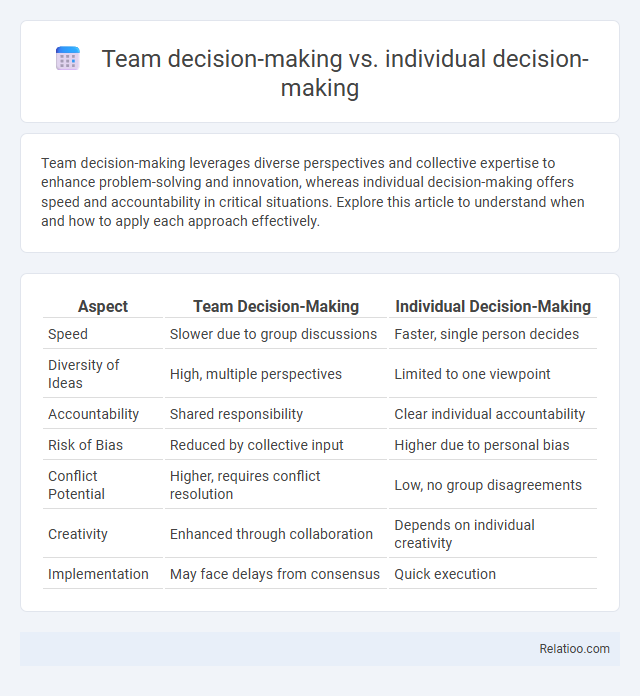Team decision-making leverages diverse perspectives and collective expertise to enhance problem-solving and innovation, whereas individual decision-making offers speed and accountability in critical situations. Explore this article to understand when and how to apply each approach effectively.
Table of Comparison
| Aspect | Team Decision-Making | Individual Decision-Making |
|---|---|---|
| Speed | Slower due to group discussions | Faster, single person decides |
| Diversity of Ideas | High, multiple perspectives | Limited to one viewpoint |
| Accountability | Shared responsibility | Clear individual accountability |
| Risk of Bias | Reduced by collective input | Higher due to personal bias |
| Conflict Potential | Higher, requires conflict resolution | Low, no group disagreements |
| Creativity | Enhanced through collaboration | Depends on individual creativity |
| Implementation | May face delays from consensus | Quick execution |
Introduction to Decision-Making Approaches
Decision-making approaches vary significantly between individual and team contexts, influencing outcomes and effectiveness in organizational settings. Individual decision-making leverages personal expertise and speed, while team decision-making harnesses diverse perspectives, leading to more comprehensive solutions but potentially longer processes. Interdependency among team members necessitates coordination and communication, enhancing collective problem-solving but requiring alignment of goals and roles for optimal results.
Defining Team Decision-Making
Team decision-making involves multiple individuals collaboratively analyzing information, sharing diverse perspectives, and reaching consensus to solve problems or pursue goals, fostering creativity and collective ownership. Unlike individual decision-making, which relies solely on a single person's judgment and expertise, team processes leverage interdependency, where each member's input influences outcomes, enhancing accuracy and commitment. Your ability to navigate these dynamics significantly impacts organizational effectiveness by balancing speedy resolutions with comprehensive, well-rounded choices.
Understanding Individual Decision-Making
Individual decision-making involves analyzing personal goals, preferences, and available information to reach a conclusion independently. Understanding your cognitive biases and decision-making style enhances the accuracy and efficiency of choices. Unlike team decisions or interdependency scenarios, individual decisions rely primarily on self-assessment and personal accountability.
Key Advantages of Team Decision-Making
Team decision-making leverages diverse perspectives, enhancing problem-solving and creativity beyond individual capabilities. Your team's collaborative efforts lead to more informed and balanced outcomes while distributing risk and fostering commitment among members. Interdependency within teams strengthens accountability and promotes a cohesive approach to complex challenges.
Key Advantages of Individual Decision-Making
Individual decision-making enables faster resolution due to streamlined processes and personal accountability, reducing delays caused by group consensus. It fosters clear responsibility, allowing decision-makers to be directly linked to outcomes and facilitating swift implementation. Enhanced focus on expertise and intuition in individual decisions often leads to innovative solutions tailored to specific challenges without the complexity of coordinating multiple perspectives.
Common Challenges in Team Decisions
Common challenges in team decision-making include conflicting opinions, communication barriers, and social loafing, which can hinder consensus and delay outcomes. Individual decision-making may avoid these issues but often lacks diverse perspectives, reducing solution quality and innovation. Your ability to navigate interdependency involves balancing autonomy with collaboration to improve decision accuracy and foster accountability within the group.
Risks and Drawbacks of Solo Decision-Making
Solo decision-making often increases the risk of cognitive biases, such as confirmation bias and overconfidence, leading to less objective outcomes. Your decisions may suffer from a lack of diverse perspectives, resulting in overlooked risks and limited problem-solving strategies. Unlike team or interdependent decision-making, individual choices can suffer from reduced accountability and inadequate consideration of complex scenarios.
Contexts Best Suited for Team Decisions
Team decision-making excels in complex contexts requiring diverse expertise and collective problem-solving, such as strategic planning or crisis management. Your organization benefits when decisions involve multiple perspectives, shared responsibilities, and high interdependency among tasks or departments. Individual decision-making is better suited for routine or time-sensitive situations where quick, autonomous choices are essential.
Situations Favoring Individual Decision-Making
Situations favoring individual decision-making often involve tasks requiring quick judgment, minimal information complexity, or highly specialized expertise, where Your personal experience drives efficiency. In contrast, team decision-making suits scenarios demanding diverse perspectives, brainstorming, or consensus-building, while interdependency emphasizes collaboration when tasks rely on shared inputs and coordinated efforts. Recognizing these distinctions enhances strategic choices, enabling optimized outcomes by aligning decision-making approaches with situational demands.
Choosing the Right Approach: Team vs Individual
Choosing the right decision-making approach depends on the complexity and interdependency of tasks; individual decision-making suits situations requiring quick, autonomous judgments, while team decision-making excels in scenarios demanding diverse expertise and collaborative problem-solving. Interdependency in tasks increases the need for collective input to ensure alignment and shared responsibility, enhancing decision quality and commitment. Evaluating the specific context, such as the urgency, impact, and required knowledge, guides whether a team or individual approach will yield optimal outcomes.

Infographic: Team decision-making vs Individual decision-making
 relatioo.com
relatioo.com